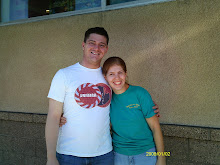*May 29, 2011*
The busload of foreigners pulled up into the vast empty parking lot, a six-foot marker reading “Imjingak” in white Roman script looming in front of it at the entrance. Less than a hundred yards to the right of the sign hung a traditional Korean victory bell in a large white gazebo, which was meant for wishing good health and harmony. Far off the lot to the left stood a small sleepy carnival, all but deserted so early on a Sunday morning.
The tour guide at the front of the bus held a portable mic in his hands. “I don’t know what the theme park’s about,” he was saying to his guests. “It’s supposed to be a memorial.” Through the crowd’s nervous laughter, he relayed the time for the tour group to be back on the bus. They’d have fifty minutes to explore the grounds—just be back by 9:30 sharp.
We had thus arrived at the first stop on our tour of the DMZ: Freedom Bridge, where North and South Korea had exchanged prisoners throughout the Korean War. In disuse due to the frail, half-century stalemate, it had been appropriated by the southern government as a place of remembrance and a monument of peace. “Are you ready for a bridge adventure?” my seatmate asked.
The first thing I stumbled upon as I mounted the two flights of stairs astride the victory bell pavilion was a large display case full of rocks. There were dozens and dozens of them “collected from 86 battlefields in 64 different countries,”—silent witness to the violent atrocities man had committed against his fellow man. “It is my sincere wish that the bringing together of these stones… will be a stepping stone for the reunification of the Korean people,” the message said, “and mark the beginning of a century of peace and harmony for all mankind.”
Just beyond the rock display and over a lip of concrete lay a pleasant row of trees with a posted warning not to photograph what lay beyond. The bare ground beneath the sign spoke a silent testament to the many feet that had belayed the order. In the distance one could see a long white bridge across the Imjingak River towards the left, severed from further connection only by a thin border of chain-linked fence.
North Korea.
I ventured to the left of the scene towards the white bridge in the distance. Another fence blocked off this part of the exhibit as well, this time covered in mourners’ ribbons. “Although I am not part of the generation who has lost,” read a fresh white ribbon in English, “I feel the enormous pain of those after coming here. I wish for unification of not just the countries but of families, friends, and lovers. 2011 SUMMER Julia Joo.” I couldn’t help but agree with her, this anonymous Julia: I hadn’t lived through the war, either, yet I felt Korea’s wound still throbbing.
On the opposite side of the ribbons stood a closed ticket counter. According to the signs it was purported to be part of a certain Gyeongui railway system, apparently a company no longer servicing rides. I couldn’t understand the juxtaposition of an empty railroad booth together with memorial ribbons—that is, until I saw the train.
Ten yards in front of the booth, an ancient locomotive rested on stunted rail line as though it were in a coffin. Above it, a wooden bridge crossed the scene respectfully like those walking along the backside of headstones. Rust covered the corpse like an orange-red burial shroud. Bullet holes riddled its sides like a scream choked at the throat just before death. Mitzubishi’s broken triangle tattooed its still flank, a testament to its once glorious youth.
North Koreans had gunned down the engine on its last run, the plaque read. And now it stood as a somber reminder of the North’s still-threatening potential for violence. A casualty of an antique war.
On the opposite side of the railway ticket booth from the memorial ribbons stood the famed Freedom Bridge, built in 2000 according to its dedication plaque for “breaking the fifty-year barrier.” It straddled a serene park fifty yards below, and pointed towards yet another string of fence. Above the jagged barbed wire curling anxiously over the top of the scene at the bridge’s end flew three flags: two for Korea and one a calming baby blue. Covered in ribbons like flower bouquets on a casket, the fence blocked off the place of exchange for the two warring brothers.
Far below in the memorial park ran a pathway along the sides of two ponds, one a deep green covered in rich vegetation and the other crystal-blue and ever-churning with a short geyser in its midst. To the left of the geyser rose a pale thin sculpture of two bent sheaves of granite loosely tied together with a dark gray granite cord. “We are the one,” its sign admitted painfully. Tears misted my eyes like a shroud of mourning as I drank in the symbolism. Yes, you are, I noted inside my head. The other just doesn’t seem to see it that way.
I looked around for my seatmate after quietly leaving the memorial, only to find him waiting to board the bus with the last stragglers just as the minute hand struck thirty. “Just in time,” he winked at me, “with the first souvenirs of the day.”
Subscribe to:
Post Comments (Atom)

No comments:
Post a Comment